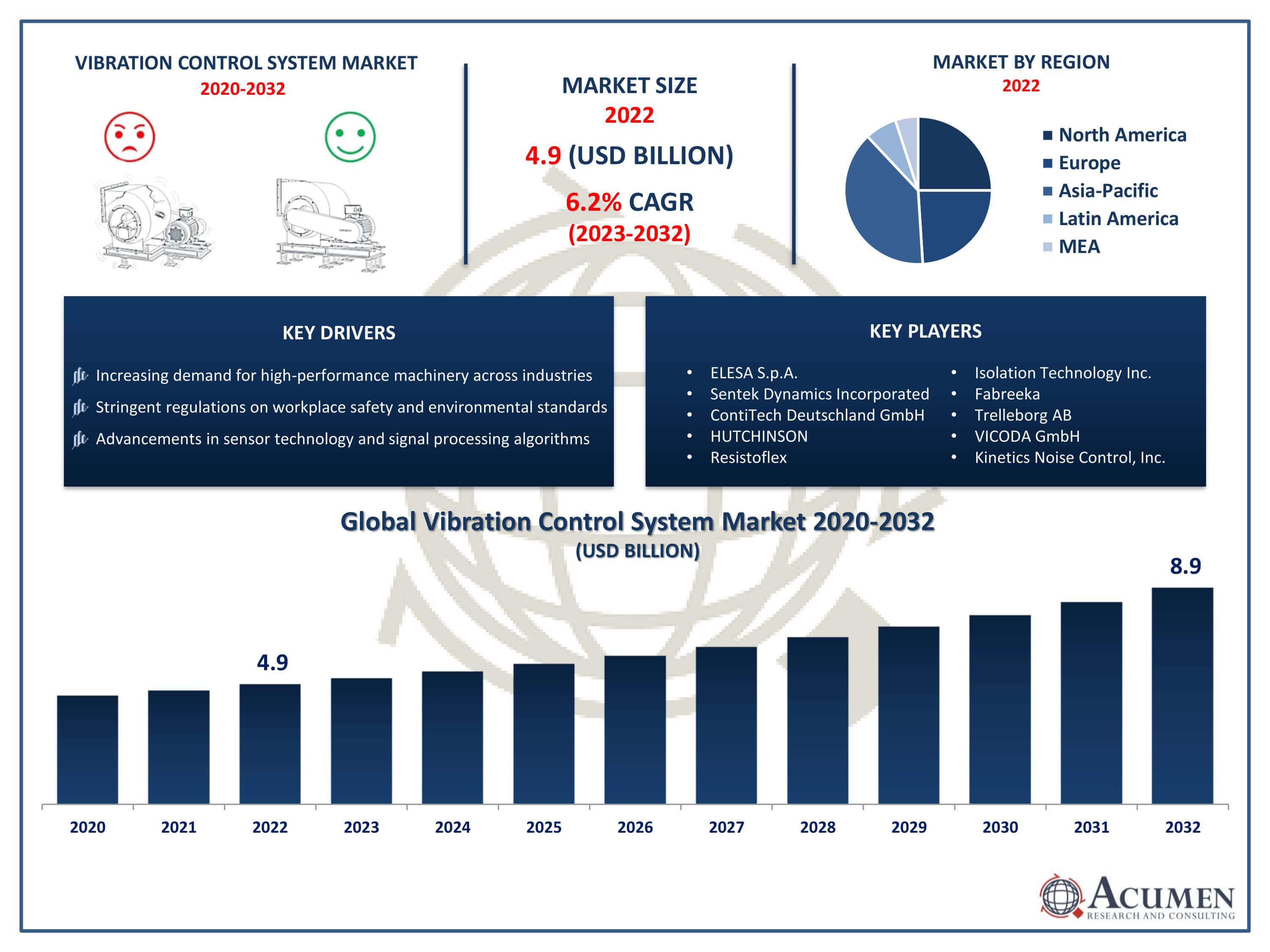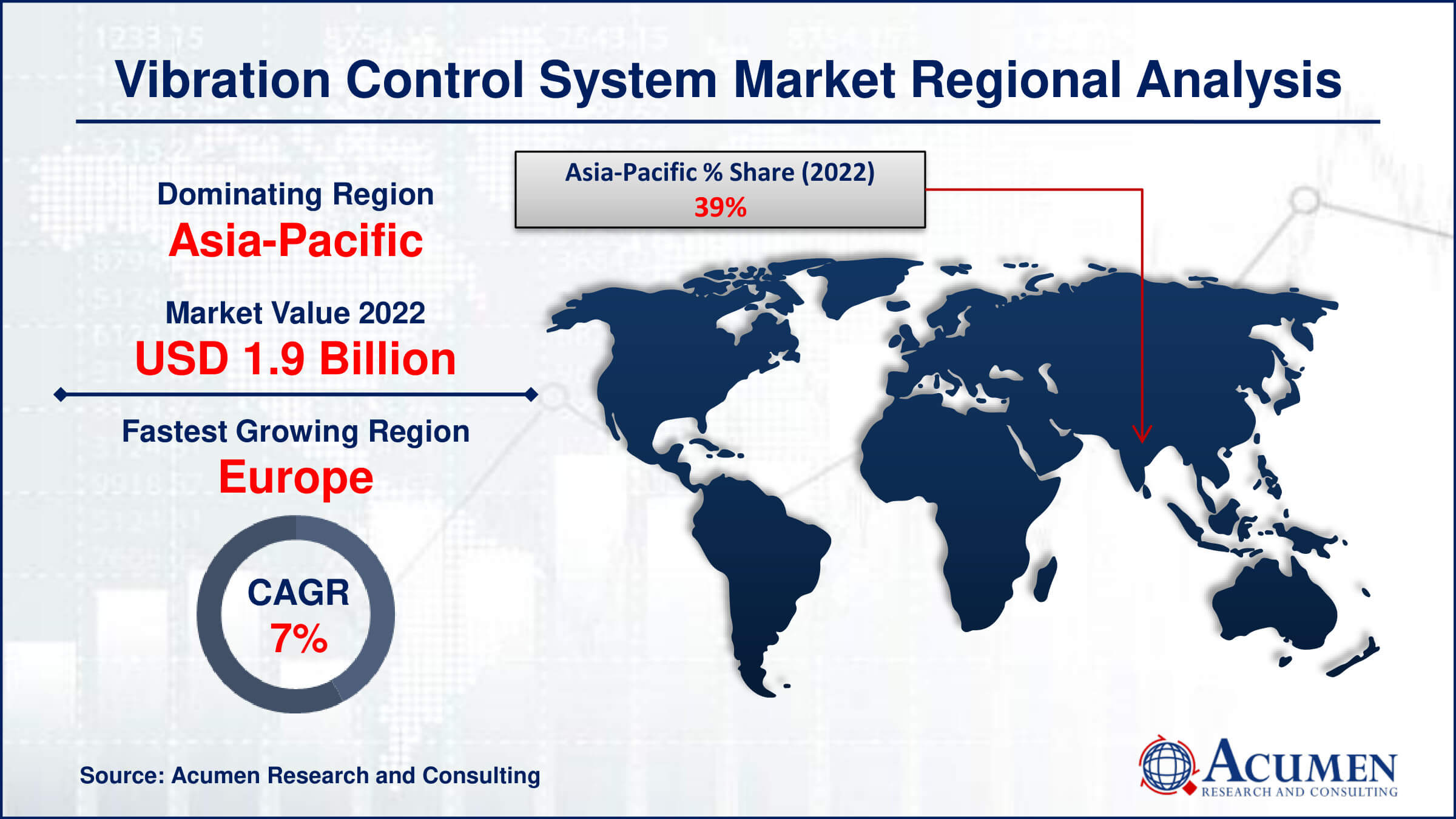June 2023
Vibration Control System Market Size accounted for USD 4.9 Billion in 2022 and is projected to achieve a market size of USD 8.9 Billion by 2032 growing at a CAGR of 6.2% from 2023 to 2032.
The Vibration Control System Market Size accounted for USD 4.9 Billion in 2022 and is projected to achieve a market size of USD 8.9 Billion by 2032 growing at a CAGR of 6.2% from 2023 to 2032.
Vibration Control System Market Highlights

A vibration control system is a technology designed to mitigate or eliminate unwanted vibrations in mechanical systems. These vibrations can arise from various sources such as machinery, engines, vehicles, or even natural phenomena like wind or earthquakes. Vibration control systems typically employ a combination of sensors, actuators, and control algorithms to detect, analyze, and counteract vibrations in real-time. By actively adjusting parameters such as force, frequency, or damping, these systems aim to minimize the adverse effects of vibrations, including structural damage, noise, and discomfort.
The market for vibration control systems has experienced significant growth in recent years, driven by several factors. One key driver is the increasing demand for precision and efficiency in various industries such as aerospace, automotive, manufacturing, and construction. As machinery and equipment become more advanced and operate at higher speeds, the need to control vibrations becomes paramount to ensure optimal performance, reliability, and safety. Additionally, stringent regulations and standards regarding noise and vibration levels in both industrial and residential environments have further fueled the adoption of vibration control solutions. Furthermore, technological advancements, including the development of smart sensors, adaptive control algorithms, and integrated systems, have expanded the capabilities and applications of vibration control systems, driving market growth even further.
Global Vibration Control System Market Trends
Market Drivers
Market Restraints
Market Opportunities
Vibration Control System Market Report Coverage
| Market | Vibration Control System Market |
| Vibration Control System Market Size 2022 | USD 4.9 Billion |
| Vibration Control System Market Forecast 2032 |
USD 8.9 Billion |
| Vibration Control System Market CAGR During 2023 - 2032 | 6.2% |
| Vibration Control System Market Analysis Period | 2020 - 2032 |
| Vibration Control System Market Base Year |
2022 |
| Vibration Control System Market Forecast Data | 2023 - 2032 |
| Segments Covered | By System Type, By Application, And By Geography |
| Regional Scope | North America, Europe, Asia Pacific, Latin America, and Middle East & Africa |
| Key Companies Profiled | ELESA S.p.A., Sentek Dynamics Incorporated, ContiTech Deutschland GmbH, HUTCHINSON, Resistoflex, Isolation Technology Inc., Fabreeka, Trelleborg AB, VICODA GmbH, and Kinetics Noise Control, Inc. |
| Report Coverage |
Market Trends, Drivers, Restraints, Competitive Analysis, Player Profiling, Covid-19 Analysis, Regulation Analysis |
A vibration control system is a technology used to manage or reduce unwanted vibrations in mechanical or structural systems. These systems typically employ a combination of sensors, actuators, and control algorithms to detect, analyze, and counteract vibrations. By actively controlling the vibrations, these systems help improve the performance, safety, and longevity of machinery and structures. Vibration control systems are utilized across various industries, including aerospace, automotive, construction, manufacturing, and civil engineering. One of the key applications of vibration control systems is in the aerospace industry, where precise control of vibrations is crucial for ensuring the safety and performance of aircraft. These systems are used to mitigate vibrations caused by engine operation, aerodynamic forces, and structural dynamics, which can affect the stability and comfort of the aircraft. Additionally, vibration control systems are employed in the automotive sector to enhance ride comfort and reduce noise levels in vehicles.
The vibration control system market has been experiencing robust growth driven by a confluence of factors. With increasing industrialization and the deployment of high-performance machinery across various sectors, the demand for vibration control solutions has surged. Industries such as automotive, aerospace, manufacturing, and construction are actively seeking ways to mitigate the adverse effects of vibrations on equipment performance, structural integrity, and worker safety. Additionally, stringent regulations and standards pertaining to workplace safety and environmental concerns have further fueled the adoption of vibration control systems. Moreover, advancements in sensor technology, signal processing algorithms, and materials science have bolstered the capabilities of vibration control systems, making them more effective and efficient. These advancements enable better detection, analysis, and mitigation of vibrations, thereby enhancing overall operational efficiency and productivity. Furthermore, the integration of vibration control systems in emerging technologies such as robotics, drones, and autonomous vehicles presents new growth opportunities for market players.
Vibration Control System Market Segmentation
The global vibration control system market segmentation is based on system type, application, and geography.
Vibration Control System Market By System Type
In terms of system types, the vibration control segment accounted for the largest market share in 2022. Active vibration control systems utilize real-time feedback from sensors to actively counteract vibrations, offering dynamic and precise control. This segment is witnessing significant growth owing to its ability to provide superior performance compared to passive systems, particularly in environments where vibrations are unpredictable or vary widely. Industries such as aerospace, automotive, and precision manufacturing are increasingly adopting active vibration control systems to enhance product quality, increase machinery lifespan, and improve overall operational efficiency. Another growing segment in the vibration control system market is smart vibration control solutions. These solutions leverage artificial intelligence, machine learning, and IoT (Internet of Things) technologies to offer predictive maintenance capabilities and real-time monitoring of equipment health.
Vibration Control System Market By Application
According to the vibration control system market forecast, the manufacturing segment is expected to witness significant growth in the coming years. Manufacturers are increasingly recognizing the importance of maintaining precise control over their production processes to ensure product quality, consistency, and efficiency. Vibration control systems play a crucial role in achieving these objectives by minimizing the impact of vibrations on machinery, which can lead to defects, reduced yield rates, and increased maintenance costs. As a result, manufacturing companies are investing in vibration control solutions to optimize their operations and stay competitive in a rapidly evolving market landscape. Additionally, advancements in manufacturing technologies, such as additive manufacturing (3D printing), CNC machining, and robotics, have led to more complex and sensitive machinery that is susceptible to vibrations. Consequently, there is a growing need for robust vibration control systems to mitigate the effects of these vibrations and maintain the accuracy and reliability of the manufacturing processes. Industries ranging from automotive and aerospace to electronics and medical devices are incorporating vibration control systems into their production facilities to meet stringent quality standards and regulatory requirements.
Vibration Control System Market Regional Outlook
North America
Europe
Asia-Pacific
Latin America
The Middle East & Africa

Vibration Control System Market Regional Analysis
The Asia-Pacific region has emerged as a dominating force in the vibration control system market due to several key factors. Firstly, the region is witnessing rapid industrialization and urbanization, driving significant demand for machinery and infrastructure across various sectors. As industries expand and modernize their operations, the need to mitigate vibrations in machinery and structures becomes critical to ensure operational efficiency and safety. This has led to a surge in the adoption of vibration control systems across industries such as automotive, manufacturing, construction, and aerospace in countries like China, India, Japan, and South Korea. Moreover, the Asia-Pacific region is home to some of the world's largest manufacturing hubs, making it a major market for vibration control solutions. With the increasing adoption of automation and advanced manufacturing technologies in the region, there is a growing demand for vibration control systems to optimize production processes, reduce downtime, and enhance product quality. Additionally, the automotive industry in Asia-Pacific is experiencing robust growth, driving the integration of vibration control systems in vehicles to improve ride comfort and reduce noise levels. These factors collectively contribute to the dominance of the Asia-Pacific region in the vibration control system market, with sustained growth expected as industrialization and technological advancement continue to accelerate across the region.
Vibration Control System Market Player
Some of the top vibration control system market companies offered in the professional report include ELESA S.p.A., Sentek Dynamics Incorporated, ContiTech Deutschland GmbH, HUTCHINSON, Resistoflex, Isolation Technology Inc., Fabreeka, Trelleborg AB, VICODA GmbH, and Kinetics Noise Control, Inc.
Looking for discounts, bulk pricing, or custom solutions? Contact us today at sales@acumenresearchandconsulting.com
June 2023
April 2021
June 2023
February 2023